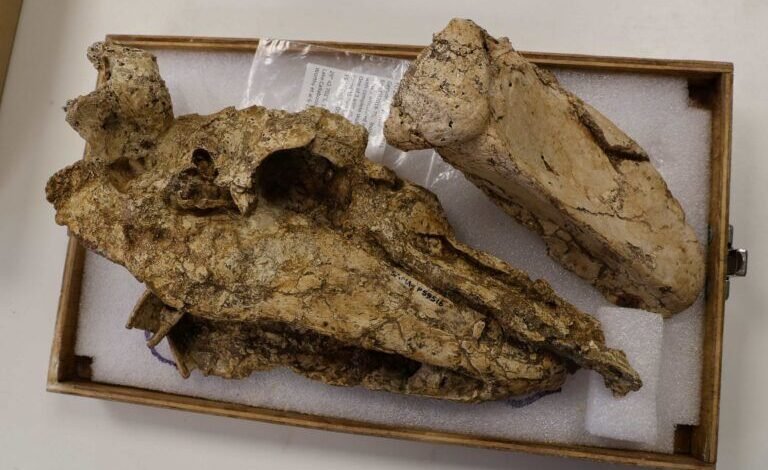Paleontologists Uncover Rare Skull of 500-Pound ‘Thunder Bird’ in Australia

:focal(384x256:385x257)/https://tf-cmsv2-smithsonianmag-media.s3.amazonaws.com/filer_public/58/82/58827d45-f434-4831-8617-5c8583281275/skull-fossil-768x512.jpg)
The fossilized remains include the most intact skull of the bird to be discovered, which helps scientists to better understand the bird’s behavior, appearance and evolution.
Flinders University
Until about 45,000 years ago, a giant, flightless bird called Genyornis newtoni roamed Australia. Known as “Newton’s thunder bird,” the species stood more than six feet tall and weighed as much as 500 pounds.
Now, in a study published Monday in the journal Historical Biology, researchers describe a well-preserved fossil of the bird’s skull for the first time.
“Seeing the skull fully out of the matrix and free from the dirt around it was definitely a ‘wow’ event,” Phoebe McInerney, first author of the study and an evolutionary biologist at Flinders University in Australia, tells Scientific American’s Kate Evans. “We weren’t really sure what to expect, and we kept finding new parts of the skull that were hidden within.”
The findings allow scientists to better understand what the bird’s head looked like, the way it behaved and how it evolved.
The researchers “did a brilliant job,” Patricia Vickers-Rich, a paleontologist at Monash University in Australia who did not contribute to the findings, tells Science’s Rodrigo Pérez Ortega.
An illustration of the large, flightless bird called Genyornis newtoni. Jacob C. Blokland (Flinders University)/https://tf-cmsv2-smithsonianmag-media.s3.amazonaws.com/filer_public/c0/60/c060391f-5c99-4bfd-9860-9723406f6614/genyornis_artboard8_50pc-scaled.jpg)
G. newtoni belongs to a clade of large, flightless birds called Dromornithidae, which first appeared in the fossil record around 55 million years ago. Scientists have been uncovering Dromornithidae fossils since the late 19th century, but a lot about their morphology has remained unknown, particularly the details relating to their skulls.
The only other G. newtoni fossil was discovered in 1913, and it was heavily damaged, according to a statement from Flinders University. One hundred years later, the research team began a six-year series of expeditions at the Lake Callabonna Fossil Reserve in Australia. They uncovered six fossils of the species and found the first near-complete skull of G. newtoni in 2019.
Like other dromornithids, G. newtoni has a large skull, a short braincase and an oversized jaw. Its long upper jaw is more unique—it has a rounded top and a bump in front of the bird’s eyes that might have been used for attracting mates.
“The beak itself is very goose-like, so we have this wide, flat rounded end,” McInerney tells Peter de Kruijff of the Australian Broadcasting Corporation (ABC News).
Jacob Blokland, a co-author of the study and vertebrate paleontologist at Flinders University, tells Science that G. newtoni was a “picky eater” that likely preferred to munch on fruits and soft leaves.
The skull had adaptations that made the massive bird well-equipped to thrive near bodies of water, the study authors write in the Conversation. Certain anatomy, including nostrils that were far back by the eyes, would have helped the bird to feed underwater. The ear was separated from areas involved in jaw movement, which allowed the creature to submerge its head without water flowing into its ears.
G. newtoni “lack obvious aquatic adaptations such as duck bills or paddling feet, but it remains possible they were closely associated with water,” Mike Lee, an evolutionary biologist at Flinders University who was not involved in the work, tells ABC News.
A size comparison between G. newtoni, a human, a cassowary and a screamer. P McInerney (Flinders University)/https://tf-cmsv2-smithsonianmag-media.s3.amazonaws.com/filer_public/60/a8/60a8e842-1572-4e00-a52a-761fb3c3f862/size-comparison.jpg)
The skull also had similarities to two waterfowl lineages—South American screamers and the Australian magpie goose. Both birds are still alive today. The findings suggest G. newtoni is more closely related to screamers than to extinct flightless birds called gastornithids, which researchers previously thought were relatives of G. newtoni, per Science.
“There’s no close analogue for these birds” anywhere else in the world, Nic Rawlence, a paleoecologist at the University of Otago in New Zealand who did not contribute to the findings, tells Scientific American. “They are a truly unique Australian island experiment, as unique as koalas and kangaroos. … With this amazing new discovery, we can now actually start to reconstruct the evolution and the behavior of this animal.”
Freshwater bodies that once dotted the area have since dried up, which may have contributed to G. newtoni’s extinction, per the Conversation.
Source link





